Okay, like, it’s spring, right? The end of the slow season, so stuff to photograph, yes? So the, you know, nature photographer blog posts are supposed to be increasing in number and quality. Stands to reason.
Well, yes, but I still have other things going on, unrelated to nature photography, so what’s been happening has been grabbing a few shots here and there (and, as yet, things haven’t started really popping,) but then not having enough time to do anything with them. I now have a little time, so we’re finally getting a post. And just because of that snark, I’m starting off with the spiders.
One spider. I shot a couple, but there’s only one I’m featuring here, for curiosity’s sake – and you know what they say about curiosity. Yet my razor-sharp naturalist wits tell me this isn’t really a cat. I just don’t know what it is.
Under the revealing reflections of the LED headlamp, I homed in on this medium-small wolf spider (genus Lycosidae,) and noticed that it seemed to have a meal, so I knelt down on the damp ground and got a reasonable closeup, but I don’t think it helped.

First off, that yellow stuff is pine pollen that’s all over every damn thing right now – in two days it accumulates enough that I can’t even tell what color my car is. But besides that, I’ve been looking at what the spider is chowing down upon and have yet to figure it out. You’re welcome to try, and to that end, I provide a little bit closer look.
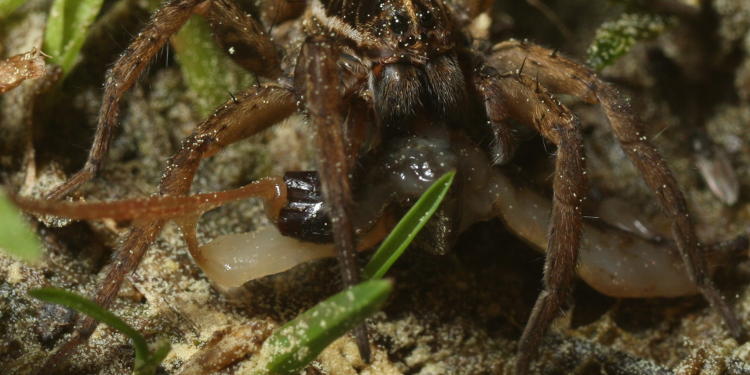
That shape, and the details that can be seen, fit absolutely nothing that I can bring to mind. I’m aware that the spider might have had this for some time and has been gnawing away at all of the outer structure, but even given that, the bits don’t seem to add up, especially that joined whatsit to the left, reddish-brown. You know, emerging from the hoof. If it helps, the width of the entire meal is probably in the 6-8mm range. I’d be happy to hear what you think, but in the meantime we’ll move on to things slightly more photogenic – we’re building up slow.
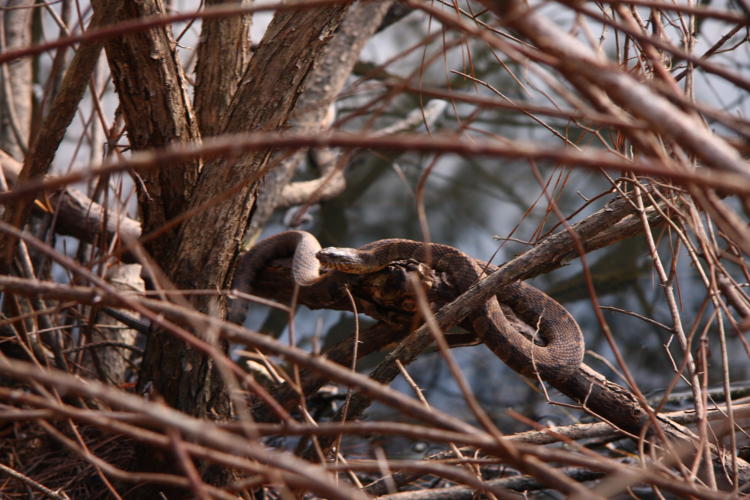
On the same evening that I shot the month-end abstract for March, I spotted a northern water snake (Nerodia sipedon sipedon) basking on a branch at the water’s edge. The light was quite low at this point and I wasn’t carrying a flash, so I did a quick couple of frames, knowing that I was toying with camera-shake from the shutter speed dropping too low, and managed to get enough of an illustrating shot, provided that you don’t get too close. Unfortunately, old habits die hard, and while I’ve been shooting with a camera body whose pop-up flash hasn’t worked for years, I forgot that I wasn’t using that body, but another that I’ve been rebuilding, one whose flash works just ducky – I could have gotten a better pic, had I been thinking. Anyway, as I went in for a closer shot, I was too incautious (or the snake overly cautious – I like that one better) and it shot into the water without hesitation. Then, as The Girlfriend pointed out, it popped up again almost immediately and sat there watching us.
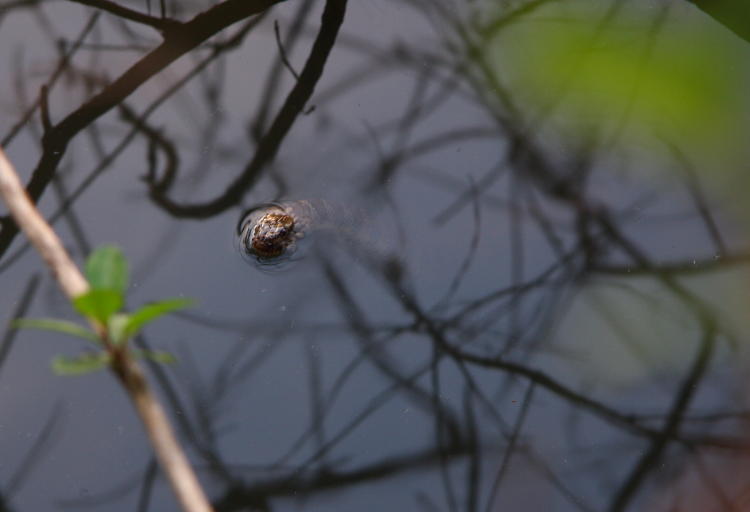
I’ve been by the same spot a few times since, but it’s been mostly at night, and so far I haven’t spotted the snake again. We’re still at a point where the evenings can get a mite chilly and it’s been hindering the movement of the snakes, at least. During the warmer daylight hours, there’s likely more activity. That was at least in evidence the other day when I was doing yard work and stirred up a tiny example.
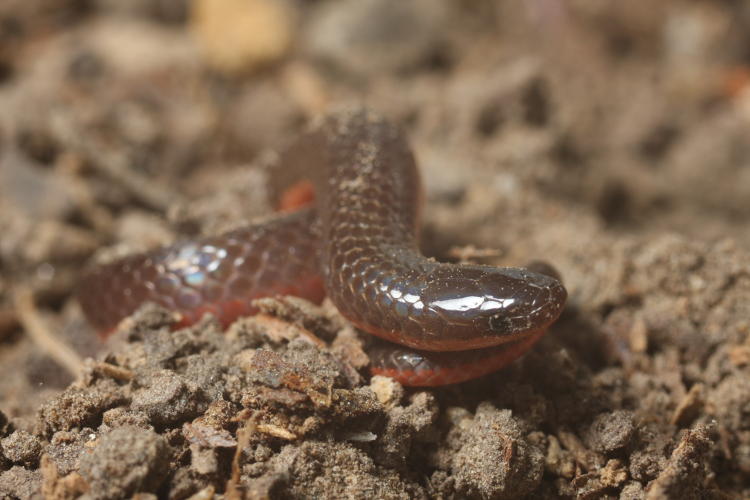
True to its namesake, this worm snake (Carphophis amoenus) is perhaps slightly larger than the average earthworm and a little more brightly colored, but otherwise it’s easy to mistake for one, at least if you’re not used to them – if you are, however, they move entirely wrong and are visibly not sticky, so when I turned it up in leaf litter I had it in hand before two seconds had passed. Then after I finished with the yard work for the day, I attempted a little photo session, which is a lot more challenging than it might sound. Provide enough of a natural-looking setting, and they’ll do exactly as their habits dictate, which is to disappear under it, and I spent a few minutes alternating between unearthing it from the litter and snagging it as it shot out of the shallow baking dish that I was using as a ‘studio’ and hurtling off across the table on the back porch. Eventually, it paused long enough to do a couple of portraits, and then I needed a scale shot.
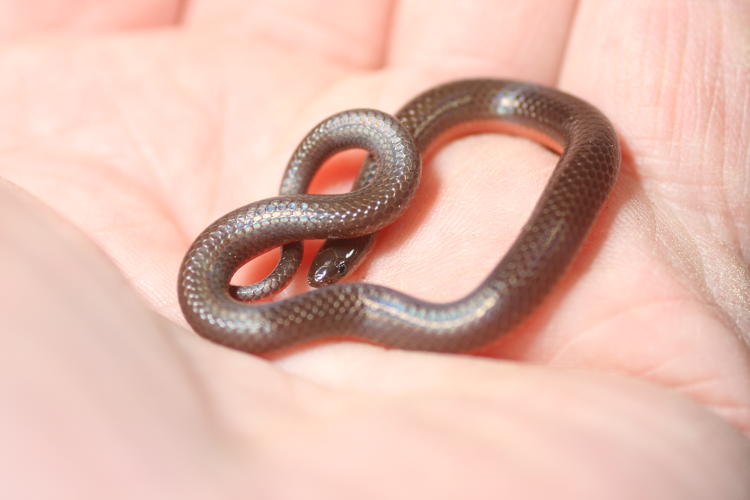
As usual, I was shooting alone, though in this diminutive case I could probably have convinced The Girlfriend to do the holding, despite her dislike of snakes in general – even she finds these guys cute. Nonetheless, I carefully cradled my model in my left hand until it settled down faintly coiled, then juggled the camera one-handed (including removing the extension tube from the lens and resetting the flash power) to shoot the snake in my own palm. The manual lens from a medium-format camera doesn’t provide auto-aperture – I usually adjust this with my left hand – so this is shot wide open at f4 with the subsequent lack of depth. I might be making things harder on myself than they need to be sometimes…
I have, time permitting, been checking on the amphibians in the backyard – I see the occasional green treefrog and less occasionally a Copes grey treefrog (Hyla chrysoscelis.) One evening, a recent emergent climbed the potted oak-leaf hydrangea sapling (Hydrangea quercifolia) and posed fetchingly on the new leaves thereon.
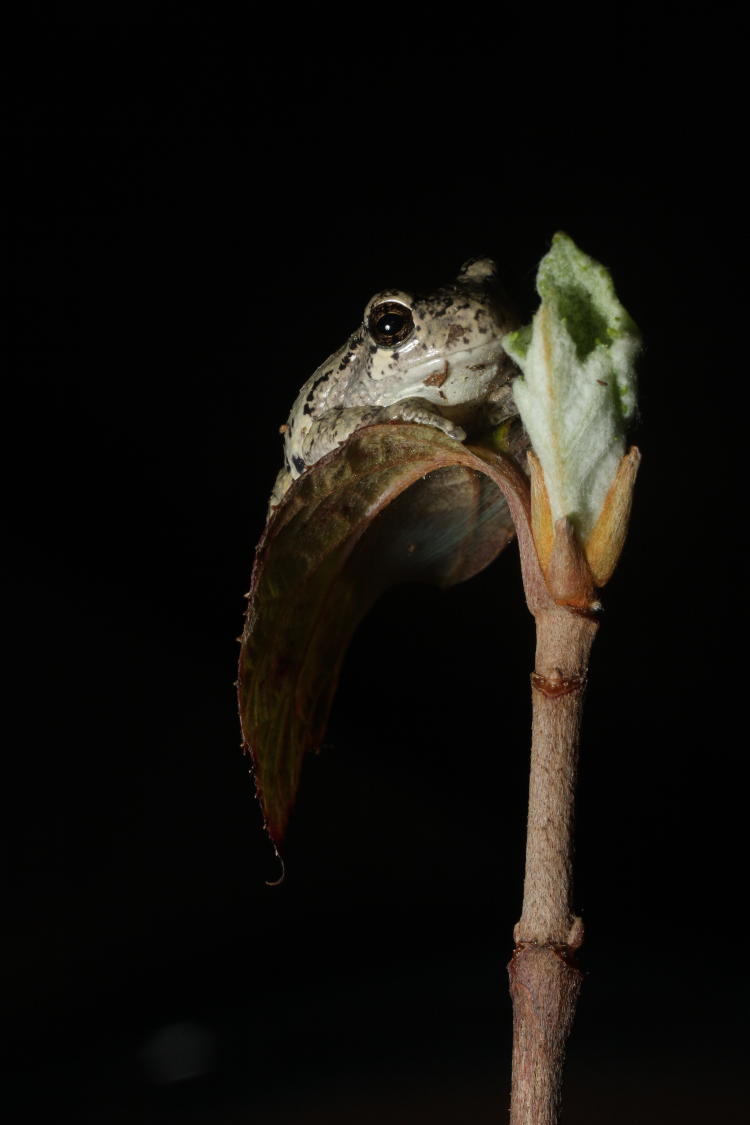
I’m still waiting to determine how many will be active in the yard this year. We had plenty of new hatchings last year, though a lot of the tadpoles and newly-emerged frogs went unidentified, but the odds were favoring the regular residents, which are these Copes greys, the green treefrogs, and the aquatic green frogs. We have several that live in the little backyard pond liner now and seem to be doing very well – they’re always the first to peek out, but also the hardest to photograph since they’re also primarily nocturnal but very spooky. I have been trying, so far unsuccessfully, to photograph one peeking out of the water, but the other evening I managed to creep up on one sitting on the bank instead.
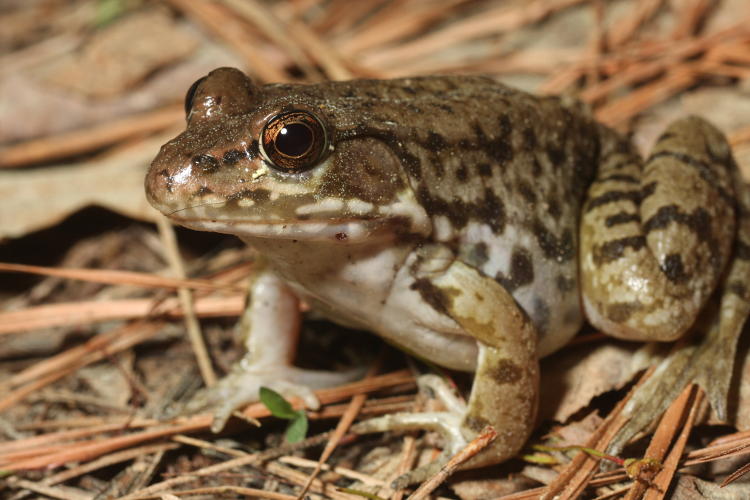
As I mentioned, this is a green frog (Lithobates clamitans,) extremely common in North Carolina, and we always have residents in the pond, though they appear capable of sharing the water with the treefrogs during tadpole season. Let’s go in tighter on that same shot for some eye detail.

I happen to like that little bronze filigree pattern, I have to admit. The overall length of this specimen was about 7-8cm, average for the species, but the size and coloration can vary a bit. As one example, I present another from the nearby, larger pond (where the water snake was) that had a solid 1-2cm in body length over the one above, sitting patiently on the grass since it likely knew that the water was a little too far away for a clean escape. However, the headlamp that I use also helps, since they’re dazzled by the bright light and thus hold still better.

I was seeing how much detail I could get from the eyes before it leapt away, and this was as close as I could get without the extension tube. But I caught a few other details as well, ones I wasn’t aware of until examining the photos on the computer back home. The scarring on the nose is obvious enough – not sure why I didn’t notice it then – and I couldn’t tell you what produced it, but it’s extensive, isn’t it? The other, much more subtle detail is atop the eye, where a small aquatic insect perched – I’m thinking it’s a form of springtail, but don’t have enough detail to be sure of that.
And one more thing, paying attention to the eyes again. The big white circle from the flash diffuser is clear enough, but then there are three points of light in there as well; these are from the headlamp, which I should probably remember to shut off when doing my shots. They’re subtle enough here, but might become distracting in other circumstances, and I have a focusing light embedded in the flash diffuser anyway. The lack of pollen across the skin of the frog tells me it wasn’t long out of the water, because, seriously, I can see the stuff passing through the beam of the headlamp like sleet.
My last shot, from the same location but a few nights earlier, also demonstrates this pretty well. This is an American toad (Anaxyrus americanus,) stoically waiting for me to finish my shots and get the hell out of its face.
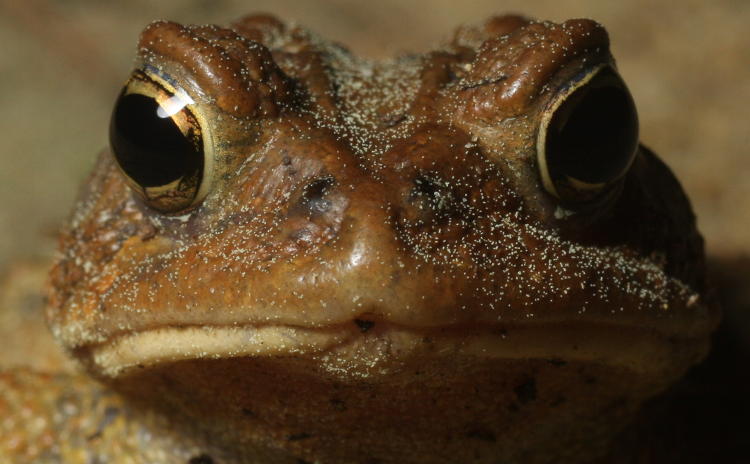
Actually, despite the dyspeptic visage, the toad wasn’t being patient at all; it was simply confused by the light, though I’d used better habits for this one and shut the headlamp off when the focusing light was on. Immediately upon my standing up and switching off the focusing light for a moment of total darkness, the toad leapt away – whether it was the sudden change of lighting, or that it could now see that I was right in front of it, it became aware of its danger and hopped a meter or so off in a flash, so abruptly that I was startled to find it missing after I switched the headlamp back on. But yeah, I do like my disturbingly close portraits, don’t I?




















































